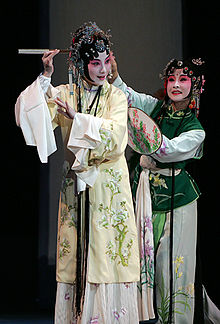User:QsCarolyn/sandbox
 | This is a user sandbox of QsCarolyn. You can use it for testing or practicing edits. This is not the sandbox where you should draft your assigned article for a dashboard.wikiedu.org course. To find the right sandbox for your assignment, visit your Dashboard course page and follow the Sandbox Draft link for your assigned article in the My Articles section. |
A-W-R, is an anonymous theatre collective and an ever-changing group of collaborators. It was founded in 2001, formed in America after the crisis of 9/11 and in the aftermath thereof. Members often self-identify as survivors of a wide variety of cultural and personal traumas. It is the collective’s operating directive that members do not share their real names in an attempt to provide a safe space for collaboration. Identity-obscuring costuming is also one of their characteristics, and this happens often in the form of different kinds of masks.
History
[edit]A-W-R have worked on projects addressing subjects from German consciousness after WWII in “We (werden nicht) Forget” to contemporary issues like the Rojava Revolution in “Jin - Jiyan _ Azadi (Women - Life - Freedom) and the #metoo movement in “Con-sent.” Notable works also include “Shut Up,” which deals with censorship of information enacted by strong nation states through manipulation of mass media and their piece “Overcoming Erasure” about the potential for individual citizenships’ “convenient” national and global narratives to be expanded through the use of social media.
These works all center around movement, and the group has said to have been influenced by names like Pina Bausch and more recently Judson Dance Theatre. Their shows also make use of technology, expanding their use of it as it has grown over their two decades of work. On this subject, they cite John Jesurun, teamLab, and Ivo Van Hove.
Mission Statement
[edit]A-W-R was created and continues to work out of a desire to explore the traces of cultural trauma across borders in an attempt to give voice to and heal affected peoples. A-W-R exists to amplify voices and to create space for community to be explored, often in arenas were it once was oppressed.
Each new work involves new collaborators, as it is integral to the company’s mission that survivors of each studied event actively participate in the staged events that touch their experiences to the extent to which each individual feels compelled. Veteran members of the group act as facilitators for new members to create, stepping in as asked to do so and stepping down where not needed. This methodology necessitates an ever-changing core of performers, and it also requires that they take measures to ensure they collaborators’ safety.
The collective is also known for exploring ways of diminishing theatrical economic and social elitism, such as through use of live-streaming their performances for audiences not able to be present at the events and offering donation-based shows. They also accept invitations to perform at non-traditional sites, and have done so in people’s workplaces, homes, and in community centers and churches.
"Our anonymity thus serves two purposes: to PROTECT members from persecution, and to have a DISTANCING effect on the audience so that identification never occurs between one individual in the audience and in the performance, but rather between the audience and the larger ideas evoked on stage. It is our belief that communities want to heal themselves. We only hope to offer tools and space." --- A-W-R
Artworks
[edit]They always prefer creating pieces responding to specific events happened at that moment.
- American Terrorist (2001)
- We (werden nicht) Forget (2004)
- The Patriot (2005)
- V iolent W riting (2007)
- MELAMINE (2008)
- SuRvIvaL (2008)
- F l e e t i n g (2009)
- RE sistance (2011)
- Overcoming Erasure (2013)
- Shut up (2014)
- Jin - Jiyan - Azadi (2015)
- Visible (2016)
- Con-sent (2017)
- Shut up II (2018)
- Overcoming Erasure II (work-in-progress)

References
[edit]Notes
[edit]
Bibliography
[edit]1. Curry, J. K, Southeastern Theatre Conference(U.S.) and SETC Theatre Symposium. The Prop's the Thing: Stage Properties Reconsidered. University of Alabama Press, 2010.
2. Powers, Sarah. "Helen's theatrical mechane: props and costumes in Euripides' Helen", Theatre Symposium, Vol.18, annual, 2010, p.23(13).
3. Mei, Todd. "Heidegger in the Machine: The Difference Between Techne and Mechane", Continental Philosophy Review, Vol.49(3), 2016, pp.267-292.
4. Volpp, Sophie. Worldly Stage : Theatricality in Seventeenth-century China. Harvard University Press, 2011.
5. Tang Xianzu. Dream in Peony Pavilion. Translated by Xu Yuanchong and Xu Ming, China Intercontinental Press and Zhonghua Book Company, 2012.
6. Swatek, Catherine Crutchfield. Peony Pavilion Onstage : Four Centuries in the Career of a Chinese Drama. Center for Chinese Studies Publications, The University of Michigan, 2002.
7. John C.Y. Wang. "MULTIFLORATE SPLENDOUR" - A COMMENTARY ON THREE ENGLISH TRANSLATIONS OF SCENE 10 OF "THE PEONY PAVILION", Journal of Oriental Studies, Vol.46(1), 2013, pp.1-33.
8. Tina Lu. Persons, Roles and Minds: Identity in Peony Pavilion and Peach Blossom Fan. Stanford University Press, 2002.
9. Zhu Hengfu. "On the Milestone in the History of the Qunqu Opera", Hundred Schools In Art, Issue 1, 2008, pp.121-126.
10. Viertel, Jack. The Secret Life of the American Musical : How Broadway Shows Are Built. Sarah Crichton Books, 2017.
11. Conte, David M and Langley, Stephen. Theatre management : Producing and Managing the Performing Arts. EntertainmentPro, 2007.
12. Stein, Tobie S and Bathurst, Jessica. Performing Arts Management: A Handbook of Professional Practices. Allworth Press, 2008.
13. Kotler, Philip and Scheff, Joanne. Standing Room Only: Strategies for Marketing the Performing Arts. Harvard Business Review Press, 1997
